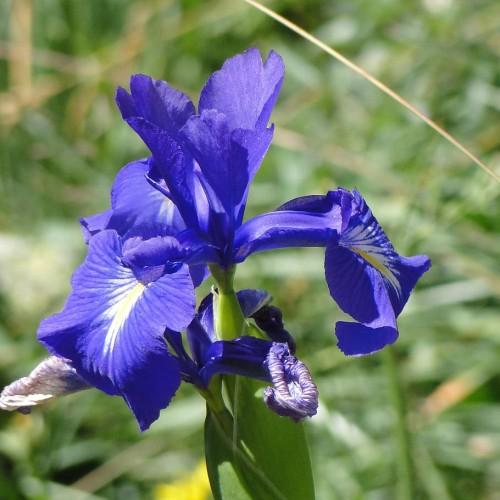
iris
Iris reticulata 'Clairette'
Cycle:
Perennial
Watering:
Average
Hardiness Zone:
5 - 9
Flowers:
Flowers In Spring
Sun:
Full sun,part shade
Leaf:
Yes
Growth Rate:
Low
Maintenance:
Low
Salt Tolerant:
Yes
Care Level:
Medium
watering
Iris reticulata 'Clairette' should be watered thoroughly and regularly during its active growth season in the spring and early summer. Aim to keep the soil moist but not waterlogged by giving your Iris 1-2 inches of water per week. In the fall and winter periods your plant should still be watered, but much less; only when the top few inches of the soil become dry. Allow the excess water from the irrigation to drain away completely to avoid root rot. Good soil drainage is also important for this species.
sunlight
Iris reticulata 'Clairette' needs a minimum of 6 hours of direct sunlight per day in order to thrive. It should be placed in a location that gets full sun during the late morning or early afternoon and partial shade in the afternoon. Irregular lighting can make the blooms less vibrant and cause the plant to experience stress. During the summer months, it is often best to provide indirect sunlight from 11 am to 4 pm every day and partial shade from 4 pm to 7 pm.
pruning
Iris (Iris reticulata 'Clairette') should be pruned annually to encourage healthy growth and blooming. The best time to prune is early spring, just as new growth appears. Remove any dead or damaged foliage, then trim the flower stems back to a few inches above the base. If desired, lightly cut back the foliage to maintain the shape of the plant. After pruning, feed with a balanced fertilizer to help promote strong growth and abundant blooms.
FAQ
Is the Bearded Iris a popular garden plant?
Yes, the Bearded Iris is a popular garden plant. Its beautiful, showy blooms come in a variety of colors, including purple, yellow, blue, and white. Its robust, rhizomatous root system makes it an easy-to-grow, low-maintenance garden addition. The Iris grows best in soils with good drainage and full sun, and does not require frequent watering. The Bearded Iris is also deer and rabbit resistant and can add a great pop of color to any garden.
Are Bearded Iris plants easy to grow?
Bearded Iris plants are surprisingly easy to grow and are an excellent choice for both novice and experienced gardeners alike. These plants need minimal care when established and once they’re planted they require little more than occasional watering and seasonal pruning. As long as they’re grown in well-drained soil and kept in full sun, they should thrive and bloom every spring. For those looking for a low-maintenance, easy-care flower, bearded irises are an excellent choice.
Can Bearded Iris be grown in a variety of soils?
Yes, Bearded Iris can be grown in a variety of soils. As long as there is adequate drainage, Bearded Iris will grow in any soil type including clay, sand, loam and silt. The soil should also be slightly acidic to neutral, with a pH of 6 to 7. To maximize the health and well-being of the plant, fertilizer and compost should also be mixed into the soil. Additionally, Bearded Iris require several inches of organic mulch for insulation and moisture retention. With the right conditions and care, Bearded Iris will produce beautiful flowers in a variety of colors.
Do Bearded Iris require full sun?
Yes, Bearded Iris do require full sun. Though they can tolerate partial shade, for best results the plants should receive about 6-8 hours of full sun each day. In addition to providing adequate sunlight, soil should be light and well-drained and water should be kept moderately moist. As an added bonus, full sun exposure helps to keep the foliage dry and minimize the potential for diseases.
Is the Bearded Iris fragrance?
The Bearded Iris fragrance is actually a type of flower known as the Iris Germanica. It has a subtle, pleasant smell that is reminiscent of irises. This flower is often used in perfume and soap-making, contributing to lighter, more subtle fragrances. The Bearded Iris can also be found in various arrangements, lending its unique scent and beauty to interior decor.
should Iris grow in spring or fall?
Iris plants should be grown in the spring. This is the best time of year to plant them as the days are beginning to warm up and there is adequate rainfall. They are able to grow roots before the soil temperatures become too hot or cold. Depending on the United States plant hardiness zone, Irises should be planted in late winter through early spring. Also, since they are heavy feeders they will benefit from having access to nutrients and moisture during the spring season.
Is the Iris a Perennial?
Yes, the Iris is an herbaceous perennial. This means it dies down to ground level each year but returns with new growth in the springtime. Furthermore, some species may naturalize and spread over time in favorable conditions. Irises can be found in a variety of colors and forms, from large and tall flower spikes on Bearded Irises to delicate blooms atop the Japanese Iris. The Iris is a versatile and low-maintenance plant that can bring a beautiful array to any garden.
Are Irises suitable for container gardening?
Yes, Irises are suitable for container gardening. They do very well in well-draining soil and require full to partial sun exposure. When growing them in containers, make sure the containers are wide enough to accommodate their roots and they are planted in a soil mix with some organic material such as compost or peat moss. It's important to keep the soil evenly moist and water when the soil dries out slightly. Be sure to fertilize the irises with a balanced fertilizer every month during the growing season for best results.
